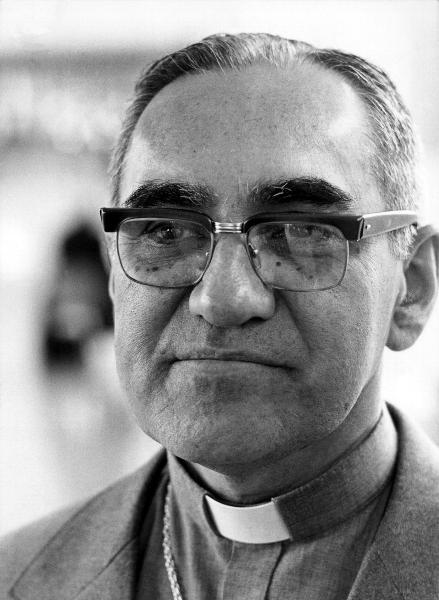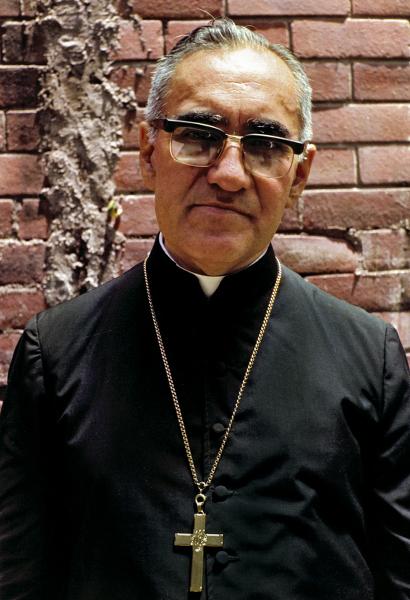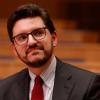
People participate in a 2017 procession to commemorate the 37th anniversary of the killing of Blessed Oscar Romero in San Salvador, El Salvador. (CNS photo/Rodigro Sura, EPA)
Pope Francis has cleared the way for slain Salvadoran Archbishop Oscar Romero to be made a saint later this year or early next, with the Vatican announcing March 7 that the pontiff has approved the declaration of a miracle attributed to the late prelate's intercession.
The move, while expected in recent months, nonetheless represents the culmination of one of the clearest turnabouts of Francis' nearly five-year papacy. The cause for Romero, who was shot dead while celebrating Mass in 1980, had languished for decades under Popes John Paul II and Benedict XVI.
But less than two years after his election as pontiff, Francis placed Romero firmly on the sainthood track, formally decreeing in February 2015 that the archbishop was assassinated as a martyr for the Catholic faith. He then authorized his beatification, the last step before sainthood, in May of that year.
Now, Francis has decreed that Romero was responsible for help in the healing of Cecilia Maribel Flores, who was facing near-certain death towards the end of a difficult pregnancy before praying to the late archbishop for his intercession.
Francis also approved a miracle for Blessed Pope Paul VI, opening the path to sainthood for the pontiff who shepherded the reforms of the Second Vatican Council, created the system of the Synod of Bishops, and also upheld the church's ban on birth control in his 1968 encyclical Humanae Vitae.
Announcement of Romero and Paul VI's canonizations are now a matter of formality: the pope needs only hold a consistory, or meeting, of the cardinals in Rome to set a date for the ceremony or ceremonies.
Recent rumors indicate Francis is considering one joint canonization ceremony: to be held in Rome in October, during the upcoming meeting of the Synod of Bishops on young people.

Archbishop Oscar Romero is pictured in an undated photo. (CNS file photo)
Romero became archbishop of San Salvador in February 1977, as his country was in turmoil over a presidential election marked by intimidation carried out by government-sponsored paramilitary forces.
As the situation deteriorated in following years, the prelate become more and more vocal in his denunciations of government killings and kidnappings that would eventually lead to El Salvador's bloody, 12-year civil war.
Where John Paul and Benedict had expressed unease with Romero's denunciations, fearing the influence of liberation theology in his writings and homilies, Francis, originally from Argentina, praises a model of a bishop caring for his people.
In a letter read aloud at Romero's 2015 beatification ceremony, the pope said the prelate "knew how to lead, defend and protect his flock."
Italian Archbishop Vincenzo Paglia, the postulator, or official promoter, of Romero's cause has called the archbishop "a martyr of the church of the Second Vatican Council." In a February 2015 talk, he said Romero "chose to live with the poor to defend them from oppression."
Theologians and experts who knew Romero or have studied his life deeply said that by setting up the prelate's canonization Francis is essentially putting forward a model for how to be a bishop.
Julian Filochowski, the chair of the UK-based Archbishop Romero Trust, said the pope is setting up an icon that other bishops can look to in determining how to go about their ministry.
"If you set up an icon, then that's what it is," said Filochowski, who knew Romero and helped draw global attention to the situation in El Salvador during the prelate's life. "It's someone you've got affection for, you've got admiration for, you've got pride in, and you're trying to follow and live."
"He not only talked the talk, he walked the walk," the trust director said of Romero. "That's what it's very difficult to find in bishops today. Romero stands there as icon."
Jesuit Fr. Martin Maier, a liberation theologian who lived in El Salvador in the 1980s and now works at the Jesuit European Social Centre in Brussels, called Romero the proto-model of a Francis-style bishop.
"He's a bishop who goes to the peripheries, who reaches out to the poor and the marginalized," said Maier, the secretary for European affairs at the Centre. "A bishop who gave his life for his people."
Romero's 'determinative point'
Before becoming archbishop, Romero had served as the secretary of the Salvadoran bishops' conference, as an auxiliary bishop of San Salvador, and as the bishop of Santiago de María, a small diocese to the east of the capital.
He was installed as archbishop on Feb. 23, 1977, three days after the controversial election of Gen. Carlos Humberto Romero as president. On Feb. 28, protestors demonstrating against the president-elect in central San Salvador were shot at by security forces, leading to the deaths of hundreds.
On March 12, Jesuit Fr. Rutilio Grande, who Romero had known for about a decade, was killed. Grande, two laymen, and three younger children were traveling in a car as groups of men surrounded the vehicle, shooting inside and killing the priest, Manuel Solorzano, and Nelson Lemusas as they protected the children.
Hearing of the assassinations, Romero left San Salvador for the rural area where the killing had taken place. He later told Grande's Jesuit provincial, Fr. Cesar Jerez, that while looking at the dead priest he thought, "If they killed him for doing what he did, then I too have to walk the same path."
Jaime Alfredo Miranda, El Salvador's current vice minister for foreign affairs, told a February conference in Rome examining Grande's witness that the priest's death was a "determinative point" in Romero's life.
Miranda, who grew up in the same area of the country where Grande lived and said he knew the priest "fairly well," noted how Romero decided after the Jesuit's death to no longer partake in state occasions "to protest the barbarity" of the killing.
Advertisement
The government official also noted that the archbishop decreed after the death that the only Mass to be celebrated in San Salvador the following Sunday would take place at the cathedral, leading much of the city's entire Catholic population to gather in one place.
"Grande represented an exemplary example of Christian witness that sparked a radical movement in Romero," said Miranda.
Mercy Sr. Ana María Pineda, a theologian at Santa Clara University who wrote a 2016 book on the relationship between Romero and Grande, said that the archbishop had considered the priest almost like a younger brother and that Grande's death played a role in a lifelong process of conversion for Romero.
"When Rutilio is killed ... [Romero] gets a moment of tremendous insight because he had great affection for Rutilio," said Pineda, author of Romero & Grande: Companions on the Journey.
"When he sees this man, who had a reputation for being a good man, he might have asked himself, 'If they're killing him, this is saying something for what he was doing,' which was defending the poor," she said.
Maier, who came to El Salvador in 1989 just before the killings of six other Jesuits and two other laypeople, said Romero’s response to Grande’s death could be a model for other bishops in their work to interpret what the Second Vatican Council called "the signs of the times."
The theologian noted the way that Romero would begin his weekly Sunday homilies with a rundown of what he called the "events of the week" — normally a summary of those who had suffered violence in some form in the preceding days.
Maier referred to one 1977 homily, given in the parish in Aguilares where Grande had served. The archbishop started the sermon by saying that as bishop he had the task of "gathering up the bodies of those who have been abused, the victims of this persecution."
"That's tremendous on a theological level," said the theologian. "When he mentioned the events of the week ... it was to consider what was happening in the past week as signs of the times, meaning signs of where God is speaking, acting, pointing."
"For me, that's a key category to understand Romero theologically," he said. "That he gave a lot of importance to the signs of the times. He was looking for the presence and the plans of God in history."
'Outstanding example' of Christian nonviolence
A military coup brought an end to Gen. Carlos Romero’s presidency of El Salvador in October 1979. But the new government proved unstable, falling apart in January 1980 before another military junta took control.
On Jan. 22, the Salvadoran National Guard opened fire on a peaceful demonstration, leaving dozens dead and hundreds wounded.
Archbishop Romero continued to speak publicly against the violence. On Feb. 17 he wrote an open letter to U.S. President Jimmy Carter, asking him to reject Defense Department proposals to provide military aid to the Salvadoran junta government.
"It would be unjust and deplorable that by the interference of foreign powers the Salvadoran people were frustrated, they were repressed, and impeded in deciding with autonomy over the economic and political trajectory that our country should follow," the archbishop told Carter.
On March 23, the fifth Sunday of Lent that year, Romero gave what would prove to be his most consequential homily. After detailing many of the incidents of violence that had taken place in prior months, he said he wanted to make a direct appeal to the members of the National Guard.

Archbishop Oscar Romero is pictured in this 1979 photo. (CNS photo/Octavio Duran)
"In the name of this suffering people, whose laments rise to heaven each day more tumultuous, I beg you, I beseech you, I order you in the name of God: stop the repression!" Romero told them, in words transmitted over national radio.
The next day, March 24, Romero celebrated an evening Mass at a hospital chapel. As he finished his homily and began to walk towards the altar, a vehicle stopped on the street in front of the building. A gunman stepped out, shot the archbishop in the chest, got back in the car and sped off.
Photos taken shortly after the incident show the dead archbishop collapsed on the floor just behind the altar, blood covering his vestments.
Filochowski, the director of the Archbishop Romero Trust, said the coming canonization has special significance during a time of numerous conflicts that Francis has called "a world war fought piecemeal."
The Briton, who Romero described as a friend in his published diaries, said that while the archbishop does not give any sort of "magic recipe" for world peace that he left behind an example of Christian witness and action.
"He remained steadfastly an agent of nonviolence," said the trust director. "The model for today is: don't be tempted into violent answers. The church has to stand out."
Noting the pope's approval of a declaration that Romero interceded to provide a miracle, Filochowski said: "One would hope the real miracles of Romero are not cures … but a change of heart, a change of mind, a change of approach."
Maier, the liberation theologian, called Romero an "outstanding example" of the witness of Christian nonviolence. He said that while the archbishop studied the conflict in El Salvador from many angles "he left no doubt that for him violence is not an option."
"On the one hand, he confronted, he analyzed, he denounced structural violence," said the Jesuit. "On the other hand for him it was clear he would not accept counter-violence as a solution."
Pineda, a native Salvadoran, said the archbishop is a model not only for other bishops but for all Christians. "Romero for me is a model of how one lives with that fragility and what one does with your humanity and your limitations," she said.
"Romero is very conscious of his limitations, "said the theologian. "He doesn't arrive to this preferential option for the poor, or any part of how he lives his Christian life, overnight. It's a journey."
"If one were to read his spiritual diary, you see constantly how he's asking God to be a better person," she continued. "He's asking God to please help him forgive, to be a more patient person."
[Joshua J. McElwee is NCR Vatican correspondent. His email address is jmcelwee@ncronline.org. Follow him on Twitter: @joshjmac.]








